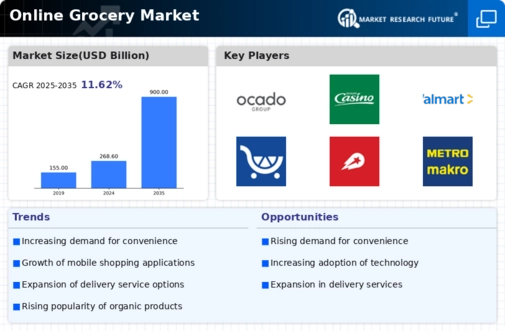Rise of Sustainable Practices in Retail
Sustainability is becoming an increasingly important consideration for consumers, influencing their purchasing decisions within the Online Grocery Market. As awareness of environmental issues grows, consumers are gravitating towards retailers that prioritize sustainable practices, such as eco-friendly packaging and responsible sourcing. Data shows that nearly 70% of consumers are willing to pay more for sustainable products. This shift is prompting online grocery retailers to adopt greener practices, which not only appeal to environmentally conscious shoppers but also enhance brand loyalty. The Online Grocery Market is thus likely to evolve, with sustainability becoming a core component of business strategies.
Technological Advancements in E-commerce
Technological advancements play a pivotal role in shaping the Online Grocery Market. Innovations such as mobile applications, artificial intelligence, and machine learning enhance the shopping experience by providing personalized recommendations and streamlined checkout processes. Data indicates that retailers utilizing advanced technology have seen a 30% increase in customer retention rates. Furthermore, the integration of augmented reality and virtual shopping experiences may redefine how consumers interact with products online. As technology continues to evolve, the Online Grocery Market is likely to witness increased competition among retailers striving to offer superior digital experiences, thereby attracting a larger customer base.
Increased Consumer Demand for Convenience
The Online Grocery Market experiences a notable surge in consumer demand for convenience. As lifestyles become increasingly hectic, consumers seek efficient solutions for their grocery needs. This trend is evidenced by a significant rise in online grocery sales, which reached approximately 20% of total grocery sales in recent years. The convenience of shopping from home, coupled with the ability to schedule deliveries, appeals to a broad demographic, including busy professionals and families. This shift towards online shopping is likely to continue, as consumers prioritize time-saving options. The Online Grocery Market is thus positioned to capitalize on this growing demand, potentially leading to further innovations in delivery and service offerings.
Expansion of Delivery and Logistics Networks
The expansion of delivery and logistics networks is a critical driver for the Online Grocery Market. As competition intensifies, retailers are investing heavily in enhancing their supply chain capabilities to ensure timely and efficient deliveries. Recent statistics indicate that companies with robust logistics systems can achieve delivery times of under two hours, significantly improving customer satisfaction. This focus on logistics not only enhances the shopping experience but also allows retailers to reach underserved markets. The Online Grocery Market is thus likely to see continued investment in logistics infrastructure, which may further accelerate growth and improve service levels.
Growing Health Consciousness Among Consumers
The Online Grocery Market is significantly influenced by the growing health consciousness among consumers. As individuals become more aware of the importance of nutrition and wellness, there is a marked increase in demand for organic and health-oriented products. Recent data suggests that sales of organic groceries have surged, accounting for nearly 15% of total grocery sales. This trend is prompting online retailers to expand their offerings to include a wider range of health-focused products. Consequently, the Online Grocery Market is adapting to meet these evolving consumer preferences, which may lead to the introduction of new product lines and partnerships with health brands.

















Leave a Comment